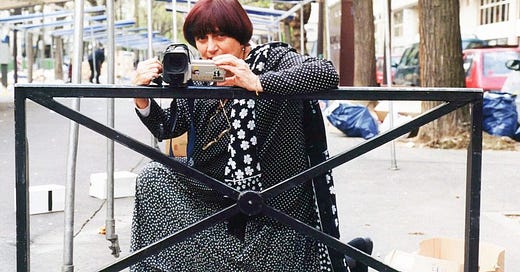Daguerréotypes + The Gleaners & I (Agnès Varda, 1975 + 2000)
Tuesday the 24th of October 5:30pm, Richard Hoggart Building cinema
Join us on Tuesday the 24th of October at 5:30pm in the Richard Hoggart Building cinema for a double bill of documentaries by one of the great masters of the form, Agnès Varda. We will screen Daguerréotypes (1975) first at 5:45pm, which will run for 1 hour 20 minutes and finish at 7:05pm. After a ten minute break, The Gleaners & I (2000) will start at 7:15pm and run for 1 hour 22 minutes, finishing at 8:35pm.
Agnès Varda (1928-2019) was one of the leading directors of the French New Wave, known as much for her narrative feature films - La Pointe Courte (1955), Cléo from 5 to 7 (1962), Vagabond (1985) – as for her documentaries, of which The Gleaners and I is perhaps the most revered. However, in the two decades leading up to her death in 2019, she worked primarily in documentary, for both film and television, including major late works like The Beaches of Agnès (2008), Faces Places (2017) and Varda by Agnès (2019).
Daguerréotypes (1975) was Varda’s first feature-length documentary. With a young son at home, Varda chose the street where she lived as her subject in order to remain close to him. The film looks at the shops on her street, the Rue Daguerre, examining the lives of the people who help provide food, clothes, haircuts and meet the other basic needs of the area’s occupants – though of course mediated by market exchange. With her characteristic curiosity and warmth, Varda depicts their rituals of work and uncovers their inner lives and relationships. Described by The New Yorker’s Richard Brody as “one of the great modern documentaries”, Daguerréotypes showcases Varda’s most distinctive and appealing qualities – wit, generosity, social curiosity and political acuity.
Les Glaneurs et La Glaneuse [The Gleaners and I] (2000) is surely one of the finest documentaries ever made, and perhaps the best-loved film of Varda’s career. The film’s subject is the French feudal customary right of ‘gleaning’, in which peasants – usually peasant women – were entitled by law to collect remaining produce left on the ground after the harvest period was over – a kind of limited feudal form of welfare. Immortalised in Millet’s famous 1857 painting Des glaneuses, which forms one of the film’s starting points, Varda considers various manifestations and equivalents of ‘gleaning’ in contemporary France, a trail which leads her and her handheld digital camera to examine modern capitalist agriculture, the impact of globalisation, ecology, poverty and more.
Despite the political stakes of the issues she considers, Varda approaches her subject with a humour, generosity of spirit and lightness of touch that makes this perhaps one of the most playful and enjoyable ‘social’ documentaries ever made. The very form of the film’s investigation echoes the practice of ‘gleaning’, as Varda picks up stories and tangents, encountered seemingly by chance, that enliven her subject: heart-shaped potatoes; a lawyer in a cabbage patch; a winegrower writing a philosophical treatise; a man who forages salad left after farmers markets. Over time, the film gradually builds up into a social portrait of France at the turn of the millennium.
The Gleaners and I was voted the eighth best documentary of all time in a 2014 Sight and Sound poll, and came 67th in the magazine’s 2022 ‘Best Films of All Time’ poll. For more about the film, see this essay for the film’s Criterion release by Larissa Pham. See also Lauren Elkin’s 2017 essay for the Paris Review, “Agnès Varda’s Ecological Conscience”.




